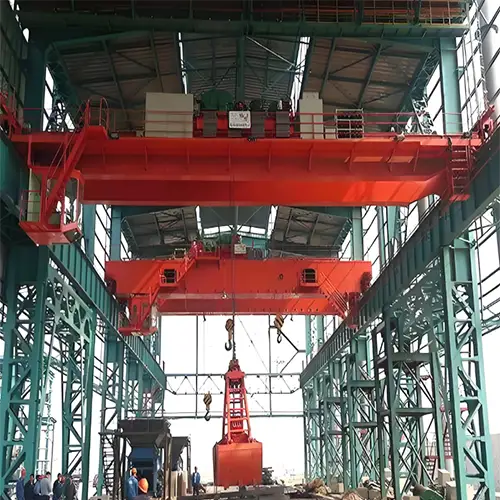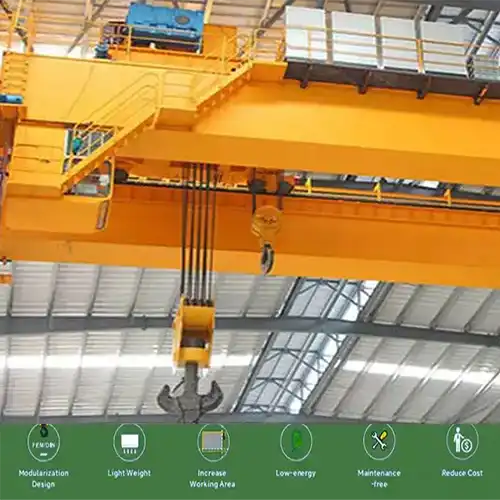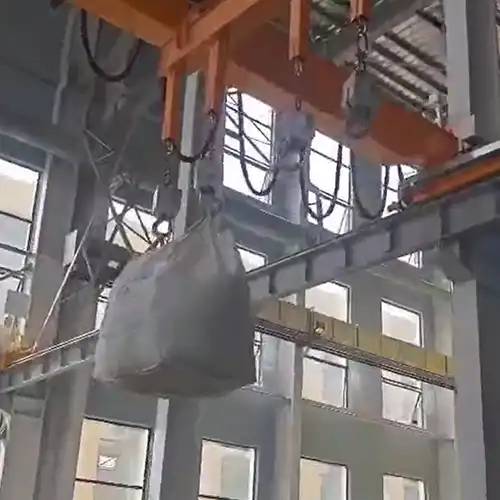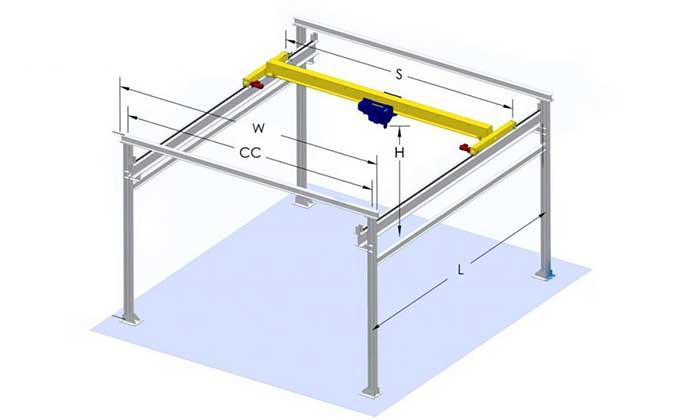Overhead Bridge Crane for Ash Handling in Concrete Manufacturing
This guide covers overhead bridge cranes for efficient ash handling in concrete manufacturing, detailing types, applications, benefits, and best practices.
Category: Bridge Crane
Your Trusted Overhead Bridge Crane Manufacturer & Supplier
Overhead Bridge Crane for Ash Handling in Concrete Manufacturing
This guide covers overhead bridge cranes for efficient ash handling in concrete manufacturing, detailing types, applications, benefits, and best practices.
Overhead bridge cranes are essential in the concrete manufacturing industry, particularly for managing ash, especially fly ash. Fly ash is a byproduct of coal combustion and is increasingly used in concrete to enhance its properties. The use of overhead cranes significantly streamlines the process of moving ash from storage silos to batching plants, ensuring that production runs smoothly and without delays.
These cranes are designed to handle the specific challenges associated with ash, such as its weight and fine particle nature. By efficiently transferring ash, they help maintain a continuous flow of materials, which is vital for meeting production schedules.
In this guide, we will explore the key aspects of ash handling bridge cranes, including their design features, operational principles, advantages, and best practices for safe and efficient use. Understanding these elements can help manufacturers optimize their operations, enhance productivity, and improve the quality of their concrete products.
Overview of Ash Handling Bridge Cranes
Ash handling bridge cranes are specifically engineered with grab bucket to facilitate the movement and management of ash materials in concrete manufacturing facilities. These grab overhead cranes are vital for ensuring that fly ash is efficiently transported from storage silos to batching plants, thus supporting the overall production process. Their design allows for high flexibility and precision in handling materials, making them an integral part of modern concrete manufacturing operations.
Typically, an ash handling bridge crane consists of a horizontal bridge that spans the width of the facility. This bridge is supported by end trucks, which are equipped with wheels that run on elevated rails, enabling smooth and easy movement across the workspace. The combination of these components allows for both vertical and horizontal lifting capabilities, essential for handling bulk materials like ash.
Components of Ash Handling Bridge Cranes
- Bridge Girder:
The bridge girder is the primary structural element of the crane. It spans the entire workspace and supports the hoisting mechanism, ensuring stability and strength during operation. Made from high-strength steel, the bridge girder is designed to withstand heavy loads and dynamic forces, ensuring safe and reliable operation. The design can vary, with options for single or double girders, depending on the required lifting capacity. - Hoist:
The hoist is the key lifting mechanism of the crane. It raises and lowers loads with precision, typically featuring hooks, grabs, or specialized attachments designed for handling ash. Many hoists are equipped with variable speed controls, allowing operators to adjust the lifting speed according to the specific requirements of the task. The hoist's design is crucial for ensuring smooth operation, minimizing wear, and maximizing efficiency. - End Trucks:
End trucks are the mobile units that house the wheels of the crane. They allow the crane to move along the runway beams, providing the necessary mobility to access different areas of the facility. Each end truck is equipped with a drive mechanism that enables controlled movement, whether manual or powered. The design of the end trucks ensures stability during operation, especially when lifting heavy loads. - Control System:
The control system is essential for the safe and effective operation of the crane. It can be either manual or automated, with options for remote control to enhance flexibility. Automated systems often incorporate advanced features like load sensing, overload protection, and programmable logic controllers (PLCs) for optimized performance. This allows operators to make precise adjustments to the crane's movements, improving efficiency and safety during ash handling operations.
These components work together seamlessly to ensure that ash handling bridge cranes operate efficiently, safely, and effectively, making them indispensable in the concrete manufacturing process.
Types of Ash Handling Bridge Cranes
When selecting an ash handling bridge crane, it's important to consider the specific needs of your facility. The two primary types of cranes used in ash handling are single girder and double girder cranes, each designed to meet different operational requirements.
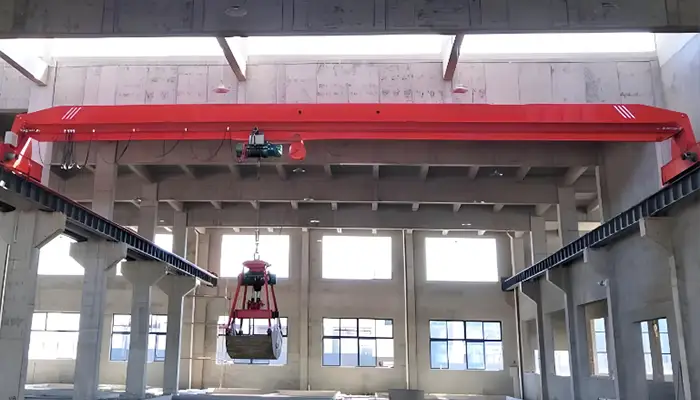
single girder grab bucket overhead crane for sale 5 ton to 15 ton
Single Girder Overhead Bridge Cranes
Single girder overhead bridge cranes are an ideal solution for facilities that manage lighter loads and have space constraints. These cranes are characterized by a single main beam, known as the girder, which serves as the primary structural component. This design offers several advantages that make single girder cranes a popular choice, particularly for smaller concrete manufacturing plants.
Design and Construction The single girder configuration allows for a simpler and more streamlined design. With only one main beam, the crane requires less material compared to double girder systems, resulting in a lighter overall structure. This reduction in weight means that the supporting framework, such as columns and runway beams, can also be lighter, leading to lower construction and installation costs.
The hoisting mechanism is typically mounted on top of the girder, allowing for optimal lifting height and ease of access. This design maximizes the available lifting height while minimizing the overall height of the crane system, making it suitable for facilities with low headroom.
Capacity and Applications Single girder overhead bridge cranes generally have a lifting capacity ranging from 5 to 15 tons. This makes them well-suited for handling smaller quantities of ash or lighter materials. In concrete manufacturing, they can effectively load and unload bulk ash from storage containers, transport materials within the facility, and assist in batching operations.
These cranes are particularly beneficial in facilities where space is at a premium. Their compact design allows them to navigate tighter areas more easily, making them ideal for operations that require efficient material handling without the footprint of larger equipment.
Cost-Effectiveness One of the standout features of single girder overhead bridge cranes is their cost-effectiveness. The lower material requirements not only reduce initial purchase costs but also lead to lower installation expenses. Maintenance costs tend to be lower as well, given the simpler design and fewer components that require servicing. This makes single girder cranes an attractive option for smaller concrete plants operating on tighter budgets.
Ease of Installation and Operation The installation process for single girder overhead bridge cranes is generally straightforward, allowing for quicker setup times. Their ease of use makes them accessible for operators who may be less experienced, as they are often simpler to control than more complex crane systems. Many single girder cranes are available with various control options, including pendant controls, remote controls, or automated systems, enhancing their usability.
In summary, single girder overhead bridge cranes provide a practical and efficient solution for lighter load applications in concrete manufacturing. Their design, capacity, and cost advantages make them a popular choice for smaller facilities looking to optimize their ash handling processes without compromising safety or efficiency.
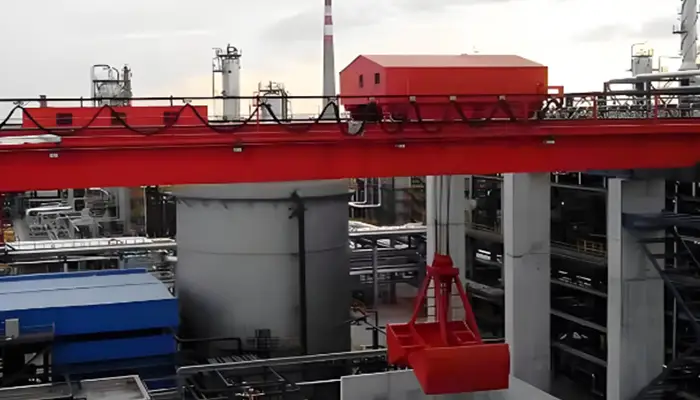
double girder grab bucket overhead crane for sale 15 ton to 50 ton
Double Girder Overhead Bridge Cranes
Double girder overhead bridge cranes are specifically engineered for heavier loads and larger facilities. Their design features two parallel girders, which provide enhanced strength and stability compared to single girder systems. This robust construction allows for significantly greater lifting capacities, often ranging from 15 to 50 tons or more, making them ideal for managing large volumes of ash in concrete manufacturing.
Design and Strength The parallel girder configuration of double girder cranes enhances their structural integrity, enabling them to support heavier loads with ease. This design is particularly advantageous in environments where heavy lifting is a daily requirement, as it ensures that the crane can handle substantial weights without compromising safety. The dual girder setup also allows for the incorporation of more complex lifting mechanisms and attachments, enhancing the crane's versatility for various tasks beyond just ash handling.
Increased Height of Lift Double girder cranes offer improved lifting height, which is particularly beneficial in operations involving tall storage silos. The design permits the hoisting mechanism to be positioned higher, maximizing the vertical space available for lifting operations. This capability is essential in facilities where height restrictions are a concern and where efficient access to materials stored at greater heights is necessary.
Versatility and Applications In addition to their primary function of handling ash, double girder cranes are versatile and can be adapted for a wide range of applications. They can be equipped with various attachments, such as clamshell buckets or specialized grabs, to manage different materials effectively. This adaptability makes them suitable for tasks like loading and unloading, transporting heavy materials between different areas of the facility, and assisting in complex batching operations.
Stability and Durability The stability and durability of double girder cranes make them a preferred choice in high-demand concrete manufacturing environments. Their robust construction is designed to withstand the rigors of daily operations, ensuring reliable performance over time. This durability reduces the likelihood of maintenance issues and extends the lifespan of the equipment, contributing to overall operational efficiency.
In summary, double girder overhead bridge cranes provide a powerful and reliable solution for handling heavier loads in larger concrete manufacturing facilities. Their design offers increased lifting capacities, improved height of lift, and versatility for a variety of tasks, making them an essential asset for operations that require efficiency, strength, and durability.
Capacity and Specifications
When selecting an ash handling bridge crane, understanding its capacity and specifications is crucial for ensuring it meets the operational needs of the concrete manufacturing facility.
Ash handling bridge cranes typically have capacities ranging from 5 to 50 tons. The specific capacity needed depends on the volume and weight of the ash being handled. For smaller operations or facilities that deal with lower volumes of ash, a crane with a capacity closer to 5 to 15 tons may suffice. However, larger plants that require the handling of bulk ash will benefit from cranes with capacities of 20 tons or more, providing the necessary strength to manage heavier loads efficiently.
The typical capacity of overhead cranes used in ash handling for concrete manufacturing generally ranges from 5 tons to 50 tons, depending on the specific requirements of the facility and the volume of ash being handled. Here's a breakdown of common capacities:
Light Duty (5 to 10 tons) Light-duty cranes are ideal for smaller operations or facilities that deal with lower volumes of ash. They are particularly suitable for handling bags or smaller loads of ash, making them an economical choice for businesses with limited material handling needs. These cranes help streamline operations without requiring significant investment or space.
Medium Duty (10 to 20 tons) Medium-duty cranes are commonly found in medium-sized concrete plants. These cranes offer the capability to move larger quantities of fly ash and can perform multiple handling tasks, such as loading, unloading, and transporting ash within the facility. Their versatility allows for improved workflow and efficiency, making them suitable for plants that require a balance between capacity and operational flexibility.
Heavy Duty (20 to 50 tons) Heavy-duty cranes are essential for high-capacity plants with significant ash handling needs. These cranes are designed for bulk handling of ash, allowing for efficient loading and unloading operations. Their robust construction supports the handling of large quantities, ensuring that operations can keep pace with production demands. This capacity level is critical for larger facilities that rely on efficient material flow to maintain productivity.
Factors Influencing Capacity
Several factors influence the selection of crane capacity in ash handling operations:
- Volume of Ash: The total amount of ash produced and required for concrete production directly impacts the necessary crane capacity. Higher production rates demand cranes capable of handling larger loads.
- Facility Layout: The design and layout of the plant may necessitate specific crane capacities. Considerations such as headroom, runway length, and space for maneuverability play a crucial role in determining the appropriate crane size.
- Operational Needs: The specific tasks that the crane will perform—such as loading, unloading, or transporting ash to various parts of the facility—affect capacity requirements. Understanding the operational demands ensures that the crane can meet the expected workload effectively.
By carefully choosing the appropriate crane capacity, concrete manufacturers can optimize their operations and ensure efficient handling of ash materials, enhancing overall productivity and safety in their facilities.
Span Length:
The span length of the crane is another critical specification. Common spans for ash handling bridge cranes range from 10 to 40 feet, although this can vary based on the facility's layout and operational requirements. A wider span allows the crane to cover more area, facilitating efficient movement between storage and batching locations. When designing the crane's span, consider the facility's dimensions and the specific tasks the crane will perform to maximize coverage and productivity.
The span length of an overhead crane is a critical specification that significantly impacts its operational efficiency. For ash handling bridge cranes, common spans typically range from 10 to 40 feet, although this can vary based on the specific layout of the facility and its operational requirements.
Importance of Span Length
A wider span allows the crane to cover a larger area within the facility, facilitating efficient movement between storage silos and batching locations. This increased coverage helps minimize the time and effort required to transport materials, which is crucial in maintaining a smooth production flow in concrete manufacturing.
Factors Influencing Span Length
When determining the appropriate span length for an ash handling bridge crane, several factors should be considered:
- Facility Dimensions: The overall dimensions of the plant play a significant role in span design. A thorough understanding of the available space helps in selecting a span that maximizes coverage without hindering other operations or workflows.
- Operational Tasks: The specific tasks the crane will perform—such as loading, unloading, and transporting ash—should guide span length decisions. For facilities where materials need to be moved across greater distances, a longer span can enhance productivity by reducing the number of trips required.
- Equipment Compatibility: Consideration should also be given to the equipment and systems in use, such as storage silos and batching systems. Ensuring compatibility between the crane's span and existing infrastructure is vital for seamless operations.
Designing for Maximum Efficiency
To maximize coverage and productivity, it is essential to design the crane's span thoughtfully. A balance must be struck between the crane's span length and its lifting capacity, as longer spans may require additional structural support to maintain stability. Additionally, integrating features such as adjustable spans or modular designs can offer flexibility, allowing for future adjustments based on evolving operational needs.
In summary, the span length of ash handling bridge cranes is a crucial factor that influences operational efficiency in concrete manufacturing. By carefully considering facility dimensions, operational tasks, and equipment compatibility, manufacturers can optimize crane design to enhance productivity and ensure effective material handling.
Lifting Height:
Lifting height is an essential factor, as it must accommodate the required clearance for storage silos and batching operations. The lifting height should be tailored to the height of the silos used for ash storage, ensuring that the crane can effectively load and unload materials without obstruction. Typical lifting heights can vary significantly based on facility design, but it's important to ensure that the crane is equipped to handle the necessary heights for safe and efficient operation.
Lifting height is a crucial specification for ash handling bridge cranes, as it must accommodate the required clearance for storage silos and batching operations. Ensuring the crane's lifting height is appropriate is essential for effective loading and unloading of materials without obstruction.
Importance of Adequate Lifting Height
The lifting height should be tailored to match the height of the silos used for ash storage. This ensures that the crane can efficiently access the top of the silos for loading, as well as unload materials at the appropriate height for batching systems. A proper lifting height helps streamline operations and minimizes the risk of accidents or equipment damage due to inadequate clearance.
Variability Based on Facility Design
Typical lifting heights can vary significantly based on the specific design and layout of the facility. Factors influencing lifting height include:
- Silo Height: The height of the storage silos directly dictates the required lifting height of the crane. Accurate measurements are essential to ensure compatibility.
- Batching Equipment: The height of the batching equipment also plays a role. The crane must be able to place ash into the batching system without obstruction, which may require additional height.
- Operational Requirements: Consideration should be given to the types of materials being handled and any unique operational processes. For instance, if the operation requires frequent movement between different levels, a higher lifting height may be necessary.
Ensuring Safe and Efficient Operation
To achieve safe and efficient crane operation, it is vital to ensure that the crane is equipped to handle the necessary lifting heights. This includes selecting the appropriate hoisting mechanism and ensuring that the crane's structural integrity can support the required height without compromising stability.
Additionally, incorporating adjustable lifting systems can offer flexibility, allowing operators to adapt to changing operational needs over time. Regular assessments of lifting height requirements should be conducted to ensure continued compliance with safety standards and operational efficiency.
In summary, the lifting height of ash handling bridge cranes is a fundamental aspect that directly impacts their functionality in concrete manufacturing. By aligning lifting heights with facility design and operational requirements, manufacturers can optimize material handling processes while ensuring safety and efficiency.
Applications of Ash Handling Bridge Cranes
Ash handling bridge cranes are versatile tools essential for various applications within concrete manufacturing. Their ability to efficiently manage ash materials contributes significantly to overall production efficiency and quality. Here are some key applications:
Loading and Unloading One of the primary functions of ash handling bridge cranes is to facilitate the loading and unloading of ash from trucks or rail cars to storage silos. This process is critical for maintaining a steady supply of fly ash for concrete production. The crane's lifting mechanism allows for quick and safe transfers, minimizing downtime and enhancing workflow. By automating this process, manufacturers not only improve safety but also reduce labor costs associated with manual handling. Efficient loading and unloading help ensure that production schedules are met, preventing delays caused by material shortages.
Transporting Ash Bridge cranes play a vital role in moving ash between various storage areas and batching plants. This capability significantly reduces the need for manual handling, which minimizes the risk of worker injuries and increases operational efficiency. With the ability to cover large spans, these cranes can transport ash directly to the batching area, ensuring a consistent flow of materials for concrete mixing. This streamlined movement reduces logistical challenges, making it easier to coordinate material flow throughout the facility. As a result, production processes become more efficient, and the overall speed of operations improves.
Batching Operations Ash handling bridge cranes can be seamlessly integrated with batching systems to ensure accurate proportions of ash in concrete mixes. This integration allows for precise control over the amount of fly ash used, which is essential for achieving the desired properties of concrete. By automating the batching process, manufacturers can ensure consistency and quality in their concrete products, reducing variability that can occur with manual measurements. This precision is particularly crucial in high-performance concrete applications, where the quality of materials directly impacts the final product's strength, durability, and workability.
Overall, the applications of ash handling bridge cranes extend beyond mere material movement; they are integral to optimizing concrete manufacturing processes. By enhancing safety, improving operational efficiency, and ensuring consistent product quality, these cranes play a vital role in the modern concrete industry. Their ability to automate and streamline various handling processes allows manufacturers to meet increasing production demands while maintaining high standards of safety and quality.
Advantages of Using Ash Handling Bridge Cranes
Ash handling bridge cranes offer numerous benefits that enhance the efficiency and safety of concrete manufacturing operations. Here are some key advantages:
Increased Efficiency By streamlining the ash handling process, bridge cranes significantly reduce downtime during production. Their ability to quickly and effectively move materials from storage to batching areas accelerates workflow, ultimately improving overall production rates. In high-demand environments, timely access to materials can directly impact output and profitability. This efficiency translates into a smoother operation, enabling manufacturers to meet tight deadlines and enhance customer satisfaction.
Improved Safety The use of overhead cranes minimizes the need for manual handling of heavy ash loads, significantly reducing the risk of workplace injuries. With automated systems in place, workers are less exposed to hazardous lifting and moving activities, creating a safer working environment. Enhanced safety measures not only protect employees but also help reduce costs associated with accidents and injuries, including medical expenses and lost productivity. A safer workplace fosters employee morale and retention, contributing to a more stable workforce.
Flexibility Ash handling bridge cranes are designed to accommodate various forms of ash, whether in bulk or packaged materials. This versatility allows manufacturers to adapt to different operational needs without requiring multiple systems for different types of ash. The ability to switch between handling methods enhances productivity and ensures that manufacturers can efficiently manage their ash resources. This flexibility is especially valuable in facilities that handle a diverse range of ash materials or need to adapt to changing production demands.
Space Utilization Overhead cranes elevate operations, freeing up valuable floor space within the facility. This vertical movement allows for better organization of materials and equipment, facilitating a more efficient workflow. By optimizing space utilization, manufacturers can improve their operational layout, making it easier to access materials and reducing congestion in work areas. Efficient space management also supports future expansions or adjustments in production lines without the need for significant restructuring.
These advantages make ash handling bridge cranes an essential component in modern concrete manufacturing, supporting increased productivity, enhanced safety, and efficient resource management. By investing in these systems, manufacturers can optimize their operations, adapt to evolving market demands, and maintain high standards of safety and quality.
Best Practices for Operation and Maintenance
To ensure the safe and efficient operation of ash handling bridge cranes, following best practices in operation and maintenance is essential. Here are key recommendations:
Operator Training Training is critical for maximizing safety and efficiency. Operators should undergo comprehensive training that covers safe crane operation, proper load handling techniques, emergency procedures, and basic maintenance checks. Regular updates to this training are necessary to incorporate new safety regulations and operational practices. Well-trained operators not only enhance safety but also improve the overall performance of the crane, leading to more efficient operations.
Regular Inspections Conducting routine inspections is vital for identifying potential issues before they escalate. Operators should regularly check components such as the hoist, cables, and control systems for signs of wear and tear. Adhering to the manufacturer's maintenance guidelines ensures all parts function optimally. Regular inspections help prevent costly downtime and extend the lifespan of the crane, ensuring consistent operational reliability and safety.
Load Management Effective load management is crucial for maintaining crane stability and safety. Operators must adhere to specified weight limits and ensure proper load distribution. This involves evenly distributing loads across the hoisting mechanism and securely attaching them before lifting. Proper load management minimizes the risk of tipping and accidents, contributing to a safer working environment and ensuring that operational efficiency is maintained.
Safety Protocols Implementing robust safety protocols is essential for protecting workers and ensuring safe crane operations. This includes installing warning signs in strategic locations, establishing safety barriers to prevent unauthorized access to operational areas, and conducting regular safety drills to prepare personnel for emergencies. A strong emphasis on a safety culture not only protects employees but also fosters a more efficient and cohesive work environment, enhancing overall productivity.
Conclusion
Ash handling bridge cranes are vital for optimizing concrete manufacturing operations, offering an efficient solution for the movement and management of ash materials. By understanding their components, applications, and best practices, manufacturers can enhance productivity and create a safer workplace. Investing in the right overhead crane system not only boosts operational efficiency but also supports sustainable practices by effectively utilizing recycled materials like fly ash in concrete production.
Customization: Customized crane solutions are essential for addressing specific facility layouts and operational needs. Tailored designs can improve efficiency by optimizing space utilization, ensuring that the crane operates seamlessly within the unique constraints of each facility. This customization enables manufacturers to adapt to varying production demands and maximize the crane's effectiveness in handling ash materials.
Technology Integration: Exploring advanced control systems and automation options can significantly enhance operational efficiency. Integrating smart technologies, such as load monitoring systems and real-time data analysis, allows for more precise control over crane operations. This not only streamlines workflows but also contributes to improved safety and productivity by minimizing human error and ensuring that operations are responsive to real-time conditions.
By embracing these considerations, manufacturers can ensure that their ash handling operations are both effective and forward-thinking. This proactive approach positions them for success in an increasingly competitive industry, enabling them to meet rising demands while adhering to best practices in safety, efficiency, and sustainability.
Related Products

Latest project
150 Ton Overhead Crane Installation Feedback – Paraguay Case
QDX 150 ton overhead crane in action in Paraguay. Installation photos, video, and client feedback show performance, safety, and heavy-lifting efficiency.
Free consultation to Confirm Parameters & Specifications and Get
Latest Crane Price & Crane Rate.
- Types of overhead cranes : _______?
- Optional: Overhead travelling crane, goliath gantry crane,Slewing jib crane, Single girder or double girder crane,small portable crane or kbk crane, etc.
- Capacity of overhead crane: _______?
- Optional: 0.25ton, 0.5 ton, 1 ton, 2 ton, 3ton, 5 ton, 10 ton,15ton, 20ton, 25 ton, 30ton,35ton, up to 550ton, etc.
- Crane span & lifting height : _______?
- Crane travelling length : _____?
- Control of overhead crane:_______?
- Optional: pendant/ remote/cabin control
- Voltage supply of overhead crane:_____?
- Eg,: 380V50/60HZ,3Phase or others,etc.
- Application/usage of crane:_______?
- Eg,: Steel mill, ,injection mold, cement,stone, concrete,granite, general manufacturing, etc.
Just leave a message via the contact form and our hoist and crane engineer will contact you with in 24working hours.
Get In Touch
